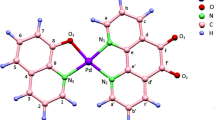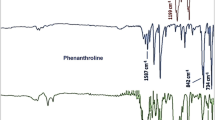Summary
Three new palladium(II) complexes of lidocaine and phenylcyanamide derivative ligands of formula K[Pd(2,6-Me2pcyd)2(LC)], 1, K[Pd(2,6-Et2pcyd)2(LC)], 2, K[Pd(2,6-Cl2pcyd)2(LC)], 3 (LC: lidocaine, 2,6-Me2pcyd: 2,6-dimethyl phenylcyanamide, 2,6-Et2pcyd: 2,6-diethyl phenylcyanamide, 2,6-Cl2pcyd: 2,6-dichloro phenylcyanamide) have been synthesized and fully characterized. The complexes 1–3 revealed a significant in vitro antiproliferative activity against human ovarian carcinoma (A2780), colorectal adenocarcinoma (HT29), breast (MCF-7), liver hepatocellular carcinoma (HepG-2) and lung adenocarcinoma (A549) cancer cell lines. All the complexes are more active than cisplatin and follow the trend 2 > 1 > 3. Mechanistic studies showed that the trend in cytotoxicity of the Pd(II) complexes is mainly consistent with their ability to accumulate into cancer cells and to increase intracellular basal reactive oxygen species levels, which consequently results in the loss of mitochondrial membrane potential and apoptosis induction.






Similar content being viewed by others
Abbreviations
- LC:
-
Lidocaine
- 2,6-Me2pcyd:
-
2,6-dimethyl phenylcyanamide
- 2,6-Et2pcyd:
-
2,6-diethyl phenylcyanamide
- 2,6-Cl2pcyd:
-
2,6-dichloro phenylcyanamide
- DMSO:
-
Dimethyl sulfoxide
- ROS:
-
Reactive oxygen species
- SRA:
-
Steroid resistant asthma
- PBS:
-
Phosphate-buffered saline
- CM-H2DCFDA:
-
5-(and-6)-chloromethyl-2′,7′- dichlorodihydrofluorescein diacetate acetyl ester
- TMRM:
-
Tetramethyl rhodamine methyl ester
- MTT:
-
3-[4,5-dimethylthiazole-2-yl]-2,5-diphenyl tetrazolium bromide
- AMC:
-
7-amino-4-methylcoumarin
- MMP:
-
Mitochondrial membrane potential
- IC50 :
-
Half maximal inhibitory concentration
- DMEM:
-
Dulbecco’s Modified Eagle Medium
- FT-IR:
-
Fourier transform infrared spectroscopy
- NMR:
-
Nuclear magnetic resonance
- HPLC:
-
High Performance Liquid Chromatography
- GFAAS:
-
Graphite furnace atomic absorption spectroscopy
References
Kelland L (2007) The resurgence of platinum-based cancer chemotherapy. Nat Rev Cancer 7:573–584
Wang D, Lippard SJ (2005) Cellular processing of platinum anticancer drugs. Nat Rev Drug Discov 4:307–320
Fiuza SM, Amado AM, Oliveira PJ, Sardao VA, Batista De Carvalho LAE, Marques MPM (2006) Pt(II) vs Pd(II) Polyamine Complexes as New Anticancer Drugs: A Structure- Activity Study. Lett Drug Design Discov 3:149–151
Riera X, Moreno V, Ciudad CJ, Noe V, Font-Bardia M, Solans X (2007) Complexes of Pd(II) and Pt(II) with 9-aminoacridine: reactions with DNA and study of their antiproliferative activity. Bioinorg Chem Appl 2007:98732
Gao E, Liu L, Zhu M, Huang Y, Guan F, Gao X, Zhang M, Wang L, Zhang WZ, Sun YG (2011) Synthesis, characterization, interaction with DNA, and cytotoxic effect in vitro of new mono- and Dinuclear Pd(II) and Pt(II) complexes with benzo[d]thiazol-2-amine as the primary ligand. Inorg Chem 50:4732–4741
Shoukry MM, Shoukry AA, Hafez MN (2011) Complex formation reactions between [Pd(piperazine)(H2O)2]2+ and biorelevant ligands: synthesis and equilibrium constants. J Coord Chem 2010(63):652–664
Valentini A, Conforti F, Crispini A, De Martino A, Condello R, Stellitano C, Rotilio G, Ghedini M, Federici G, Bernardini S, Pucci D (2009) Synthesis, Oxidant Properties, and Antitumoral Effects of a Heteroleptic Palladium(II) Complex of Curcumin on Human Prostate Cancer Cells. J Med Chem 52:484–491
Neubauera N, Palomaeki J, Karisola P, Alenius H, Kaspera G (2015) Size-dependent ROS production by palladium and nickel nanoparticles in cellular and acellular environments- an indication for the catalytic nature of their interactions. Nanotoxicology 9:1059–1066
Banerjee P, Majumder P, Halder S, Drew MGB, Bhattacharya S, Mazumder S (2015) Comparative anti-proliferative activity of some new 2-(arylazo)phenolate–palladium (II) complexes and cisplatin against some human cancer cell lines. Free Radic Res 49:253–268
Kaluerovic GN, Mijatovic SA, Zmejkovski BB, Bulatovic MZ, Gomez-Ruiz S, Mojic MK, Steinborn D, Miljkovic DM, Schmidt H, Stosic-Grujicic SD, Saboe TJ, Maksimovic-Ivanic DD (2002) Platinum(II/IV) complexes containing ethylenediamine-N,N′-di-2/3-propionate ester ligands induced caspase-dependent apoptosis in cisplatin-resistant colon cancer cells. Metallomics 4:979–987
Lv Z-M, Chen L, Tang J (2011) Nebulized lidocaine inhalation in the treatment of patients with acute asthma. World J Emerg Med 2:30–32
Finnerup N B, Biering-Sorensen F, Johannesen I L, Terkelsen A J, Juhl G I, Kristensen A D, Sindrup S H, Bach F W, T. S. hensen T S (2005) Intravenous lidocaine relieves spinal cord injury pain: a randomized controlled trial. Anesthesiology 102: 1023–1030.
De Leon-Casasola OA (2007) Multimodal Approaches to the Management of Neuropathic Pain: The Role of Topical Analgesia. J Pain Symptom Manag 33:356–364
Wilhelm IR, Tzabazis A, Likar R, Sittl R, Griessinger N (2010) Long-term treatment of neuropathic pain with a 5 % lidocaine medicated plaster. Eur J. Anesthesiology 27:169–173
Argoff CE (2013) Topical analgesics in the management of acute and chronic pain. Mayo Clin Proc 88:195–205
Sawynok J (2014) Topical analgesics for neuropathic pain: preclinical exploration, clinical validation, future development. Eur J Pain 18:465–481
Khot S, Morgan CL, Kadambande S, Poole CD (2014) Use of 5 % lidocaine medicated plasters for the treatment of pain in routine hospital practice: patient reported pain, functioning and satisfaction. Curr Med Res Opin 30:1573–1578
Giordano D, Panini A, Pernice C, Raso MG, Barbieri V (2014) Neurologic toxicity of lidocaine during awake intubation in a patient with tongue base abscess, Case report. Am J Otolaryngol 35:62–65
Berger C, Rossaint J, Van Aken H, Westphal M, Hahnenkamp K, Zarbock A (2014) Lidocaine reduces neutrophil recruitment by abolishing chemokine-induced arrest and transendothelial migration in septic patients. J. Immunology 192:367–376
Liu JB, Zhang HH, Qi ZC, Zheng XY (2014) Lidocaine protects against renal and hepatic dysfunction in septic rats via downregulation of toll-like receptor 4. Mol Med Rep 9:118–124
Cabral SA, Carraretto AR, Brocco MC, Baptista JFA, Gomez RS (2014) Effect of clonidine added to lidocaine for sub-Tenon's (episcleral) anesthesia in cataract surgery. J Anesth 28:70–75
Alster T, Garden J, Fitzpatrick R, Rendon M, Sarkany M, Adelglass J (2014) Lidocaine/tetracaine peel in topical anesthesia prior to laser-assisted hair removal: phase-II and phase-III study results. J Dermatol Treat 25:174–177
Farag E, Ghobrial M, Sessler DI, Dalton JE, Liu J, Lee JH, Zaky S, Benzel E, Bingaman W, Kurz A (2013) Effect of perioperative intravenous lidocaine administration on pain, opioid consumption, and quality of life after complex spine surgery. Anesthesiology 119:932–940
Dusmez D, Cengiz B, Yumrutas O, Demir T, Oztuzcu S, Demiryurek S, Tutar E, Bayraktar R, Bulut A, Simsek H, Dagli SN, Kilic T, Bagci C (2014) Effect of verapamil and lidocaine on TRPM and NaV1.9 gene expressions in renal ischemia-reperfusion. Transplant Proc 46:33–39
Phipps C, Lupo-Stanghellini MT, Flowers MED (2014) Treatment of refractory sclerodermatous chronic graft-versus-host disease with intravenous lidocaine infusions. Bone Marrow Transplant 49:315–316
Marret E, Rolin M, Beaussier M, Bonnet F (2008) Meta-analysis of intravenous lidocaine and postoperative recovery after abdominal surgery. Br J Surg 95:1331–1338
Guney M, Oral B, Bayhan G, Mungan T (2007) Intrauterine lidocaine infusion for pain relief during saline solution infusion sonohysterography: a randomized, controlled trial. J Minim Invasive Gynecol 14:304–310
Hirata M, Sakaguchi M, Mochida C, Sotozono C, Kageyama K, Kuroda Y, Hirose M (2004) Lidocaine inhibits tyrosine kinase activity of the epidermal growth factor receptor and suppresses proliferation of corneal epithelial cells. Anesthesiology 100:1206–1210
Khorasani-Motlagh M, Noroozifar M, Niroomand S, Patrick BO (2012) Lanthanum(III) complexes with phenylcyanamide ligands: synthesis and crystal structure. Inorg Chim Acta 383:72–77
Chiniforoshan H, Pourrahim N, Tabrizi L, Tavakol H, Sabzalian MR, Notash B (2014) Syntheses, studies and crystal structure of new coordination polymers of mercury (II) with phenylcyanamide derivative ligands. Inorg Chim Acta 416:85–92
Jazestani M, Chiniforoshan H, Tabrizi L, McArdle P, B. Notash B (2016) Synthesis, crystal structure of nickel(II) complexes of 4-nitro phenylcyanamide: Comparative in vitro evaluations of biological perspectives. Inorg Chim Acta 450: 402–410.
Tabrizi L, Chiniforoshan H (2015) Sonochemical synthesis of Au nanowires in the III-I oxidation state bridged by 4,4'-dicyanamidobiphenyl and their application as selective CO gas sensors. Dalton Trans 44:2488
Tabrizi L, McArdle P, Erxleben A, Chiniforoshan H (2015) Cytotoxicity and antimicrobial activity of triorganotin(IV) complexes of phenylcyanamide prepared by sonochemical synthesis. Inorg Chim Acta 438:94–104
Tabrizi L, McArdle P, Erxleben A, Chiniforoshan H (2015) Nickel(II) and cobalt(II) complexes of lidocaine: synthesis, structure and comparative in vitro evaluations of biological perspectives. Eur J Med Chem 103:516–529
Letcher RJ, Zhang W, Bensimon C, Crutchley RJ (1993) (1,3-Bis(2′ pyridylimino)isoindolinato)nickel(II) complexes of phenylcyanamido ligands: crystal structure, electronic absorption spectroscopy and solvent adduct studies. Inorg Chim Acta 210:183–191
Chilin A, Dodoni G, Frezza C, Guiotto A, Barbieri V, Lisa FD (2005) 4-Hydroxymethyl-1,6,8-trimethylfuro[2,3-h]quinolin-2(1H)-one induces mitochondrial dysfunction and apoptosis upon its intracellular oxidation. J Med Chem 48:192–197
Mari C, Pierroz V, Rubbiani R, Patra M, Hess J, Spingler B, Oehninger L, Schur J, Ott I, Salassa L, Ferrari S, Gasser G (2014) DNA intercalating RuII polypyridyl complexes as effective photosensitizers in photodynamic therapy. Chem Eur J 20:14421–14436
Alley MC, Scudiero DA, Monks A, Hursey ML, Czerwinski MJ, Fine DL, Abbott BJ, Mayo JG, Shoemaker RH, Boyd MR (1998) Feasibility of drug screening with panels of human tumor cell lines using a Microculture tetrazolium assay. Cancer Res 48:589–601
Hu H, Li S, Cui X, Lv X, Jiao Y, Yu F, Yao H, Song E, Chen Y, Wang M, Lin L (2013) The overexpression of hypomethylated miR-663 induces chemotherapy resistance in human breast cancer cells by targeting heparin sulfate proteoglycan 2 (HSPG2. J Biol Chem 288:10973–10985
Guha P, Dey A, Sen R, Chatterjee M, Chattopadhyay S, Bandyopadhyay SK (2011) Intracellular GSH depletion triggered mitochondrial Bax translocation to accomplish resveratrol-induced apoptosis in the U937 cell line. J Pharmacol Exp Ther 336:206–214
Crutchley RJ (2001) Phenylcyanamide ligands and their metal Complexes. Coord Chem Rev 219–221:125–155
Chen J-L, Chang S-Y, Chi Y, Chen K, Cheng Y-M, Lin C-W, Lee G-H, Chou P-T, Wu C-H, Shih P-I, Shu C-F (2008) PtII complexes with 6-(5-Trifluoromethyl-Pyrazol-3-yl)-2,2′-Bipyridine Terdentate chelating ligands: synthesis, characterization, and luminescent properties. Chem Asian J 3:2112–2123
Castineiras A, Garcia- Santos I, Saa M (2008) Synthesis, structural characterization and properties of the palladium(II) and platinum(II) complexes of 2-{2-[(pyridin-2-yl)aminomethylene]hydrazono}-thiazolidin-4-one and the 3-methyl derivative. Z Anorg Allg Chem 634:2281–2290
Novohradsky V, Liu Z, Vojtiskova M, Sadler PJ, Brabe V, Kasparkova J (2014) Mechanism of cellular accumulation of an iridium(III) pentamethylcyclopentadienyl anticancer complex containing a C,N-chelating ligand. Metallomics 6:682–690
Suzuki YJ, Jain V, Park A-M, Day RM (2006) Oxidative stress and oxidant signaling in obstructive sleep apnea and associated cardiovascular diseases. Free Radic Biol Med 40:1683–1692
Siddik ZH (2003) Cisplatin: mode of cytotoxic action and molecular basis of resistance. Oncogene 22:7265–7279
Karakas D, Cevatemrea B, Aztopal N, Ari F, Turan Yilmaz V, Ulukaya E (2015) Addition of niclosamide to palladium(II) saccharinate complex of terpyridine results in enhanced cytotoxic activity inducing apoptosis on cancer stem cells of breast cancer. Bioorg Med Chem 23:5580–5586
Zhang J, Han X, Lu X (2016) Synthesis of indole-substituted Indanones via palladium(II)-catalyzed tandem reaction of ortho-electron-deficient Alkynyl-substituted aryl aldehydes with indoles. Org Lett 18:2898–2901
Acknowledgments
We acknowledge general support from the Department of Chemistry, Isfahan University of Technology (IUT).
Author information
Authors and Affiliations
Corresponding authors
Ethics declarations
Conflict of interest
The authors, Leila Tabrizi and Hossein Chiniforoshan, declare that they have no conflict of interest.
Funding
The work was supported by the Department of Chemistry, Isfahan University of Technology in Isfahan-Iran.
Ethical approval
This article does not contain any studies with human participants or animals performed by any of the authors.
Informed consent
For this type of study, formal consent is not required.
Electronic supplementary material
ESM 1
(DOCX 4934 kb)
Rights and permissions
About this article
Cite this article
Tabrizi, L., Chiniforoshan, H. New water-soluble palladium(II) complexes of lidocaine and phenylcyanamide derivative ligands: cytotoxicity and cellular response mechanisms. Invest New Drugs 34, 723–732 (2016). https://doi.org/10.1007/s10637-016-0393-0
Received:
Accepted:
Published:
Issue Date:
DOI: https://doi.org/10.1007/s10637-016-0393-0




